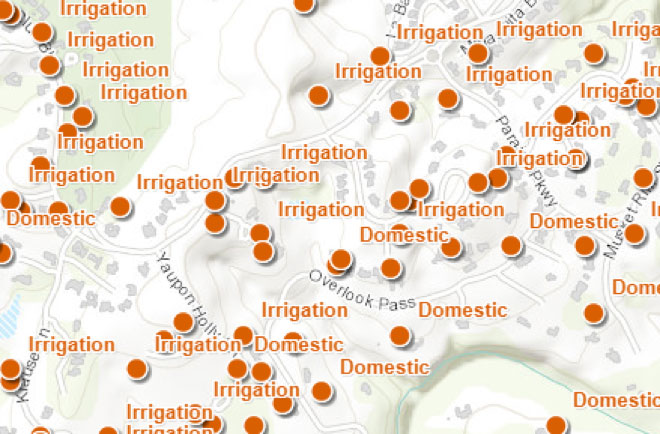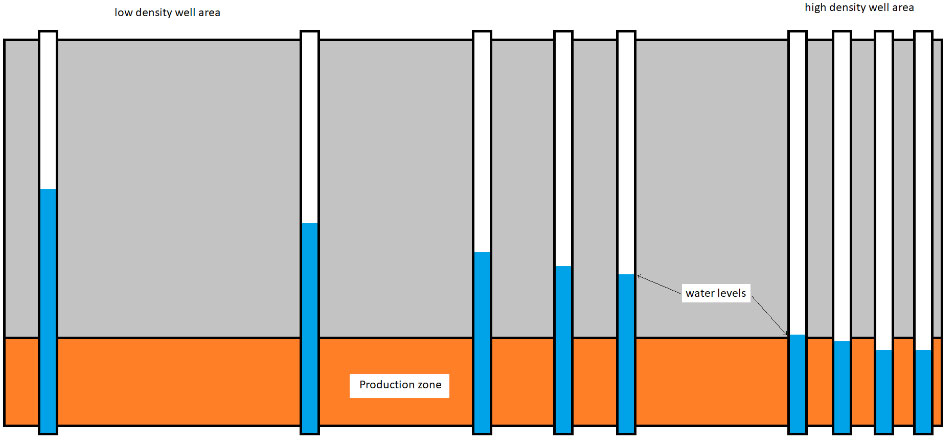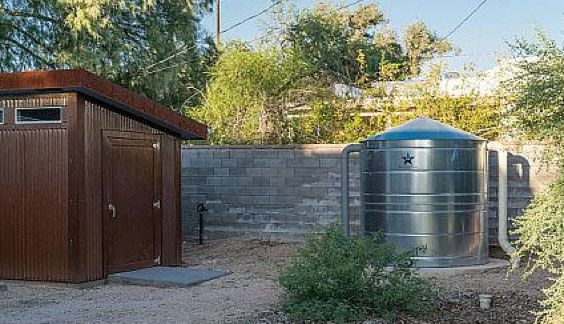I thought I knew everything there was to know about the aquifers in my service area. I was wrong. I told customers that they would never see water levels drop that far. I was wrong. I thought production zones could handle huge numbers of wells and not be stressed. I was wrong.
If you live in an area with a lot of wells, you need to understand the issues that can arise when everyone is pumping water out of the same aquifer.
Innocent beginnings

The way this starts is simple. A homeowner has a property that they want to have a well drilled. Beneath them is a massive aquifer that has plenty of water. The water level is high and they get plenty of water. They use the water for the house, irrigation, or both. And since the water is free, they use a lot of it. Why not have a nice green yard? I paid for it so why not use it? Then the neighbor wants one too. And before you know it, the subdivision looks like this picture. Everyone has a well and they are pumping all the water they want. Then the thermometer his 100 degrees and we have not had a drop of rain in two months. A disaster is looming on the horizon.
The problem.
For most of the areas that we service, we are pulling water from the massive Trinity aquifer. This aquifer is very large and has lots of water that will last for a long time. It even handles these moderate droughts well. The problem does not lie in the volume of water in the overall aquifer. The problem lies in the porosity of the formation. The Trinity is mostly a sandstone aquifer. Water flows between the grains of sand. Those spaces are very small and therefore water does not flow very fast. When you have a few wells, this formation typically can handle the demand and the water levels stay high. But, when you have high density of wells and everyone is trying to keep their grass green during dry spells, you can create a cone of depression. We have seen water levels in some areas drop as much as 400’ in a month. We set pumps deeper in the well to keep them submerged but the pump systems were designed for a high-water level. As the water level drops, the pumps move less water and build less pressure. Also, the lower the water level, the slower water flows into a well. So, a well that was making 30 gpm might only make 15 gpm or less with the low water levels because there is less pressure from the aquifer pushing water into your well.

The good news.
The problem is temporary. As soon as demand slows, the water levels return to normal. The aquifer has enough water in it to refill when the demand is normal. Therefore, there is little threat of “running out of water”. The wells don’t normally go dry unless there is another zone deeper that can be depleted by a large demand.
The solution.
There are several things that you can do to limit the impact of this problem. If you build the system with these issues in mind, you can limit the impact of these issues. Here is how you do it.

- Install a storage tank system. I know you don’t want to look at it. And the HOA might have rules against it. But this is the #1 thing you can do to help your well during low water levels. The well fills the tank and a booster pump pushes water to the demand.
- When you drill a well, drill as deep as you can without getting into bad water. Generally, the shallower wells will experience this problem more than the deeper wells.
- Make sure that the casing you install can handle the collapse pressure that will occur when the water level drops. If your casing collapses, you will have to redrill the well.
- Set the submersible pump deep in the well. As the water level drops, you will not have to lower the pump.
- Choose a pump that can operate at that deeper pump setting depth. This way you won’t have to change the pump to accommodate the low water levels.
- Use a smaller pump. If you have a storage tank, you can likely use a smaller pump. This is because the storage tank is holding so much water that you don’t have to keep up with the irrigation demand per minute. Remember that 30 gpm well that slowed to 15 gpm? If you had a 25 gpm pump in the well, you are in trouble. If you have a 10 gpm pump filling a storage tank, you won’t even notice.
Coming regulations.
Most of the area has a groundwater district. This is local governing body that regulates wells. Many of these districts already restrict the use of water. And many of them are looking to restrict the usage further. This is a good thing because they can help us get control of this issue. But, you can do your part and get a jump start on the regulations at the same time.
